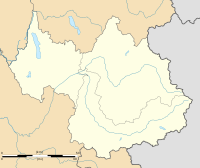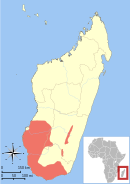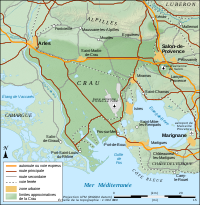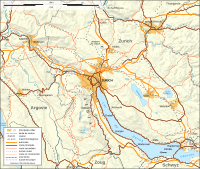I have created this page to outline the semi-official agreements we have made about maps on Wikipedia. This is a transfer from en:Wikipedia:WikiProject Maps/Conventions, this page is still unusable so use that page instead.
This is still a work in progress.
Please use en:Wikipedia:WikiProject Maps/Conventions until this page is finished.
Here are display the summary table of each major map convention use across the Wikipedias. Each convention have its own subpage, which should display: 1. an introduction explaining the style objectives and the most conventient way of creation; 2. a color summary table with two (up to date) map examples; 3. Naming convention for upload, and other advices (mainly: scale, legend); 4. an up to date SVG template; 5. further details on history, limits, and possible expansions; 5. a gallery of example.
The renaming tool being soon working on commons (source), and for admins, the naming conventions will be used to harmonized images' names.
Note that these are strongly encouraged conventions, aiming to harmonize maps on the Wikipedias, but that cartographers still have a space of freedom to fit specific needs.
 | This page and its sub-pages conventions are not yet stable.
Please do not translate now. Some months are still needed to get stable pages. |
Overview[edit]
Summary
| Convention sub-page |
Main feature and usage |
Topics (example)
|
| /Location maps (de) |
Political entity borders and divisions, focus on the subject, allow geolocation (automatic dots) |
Countries, political entities
|
| /Locator maps (blank) (en) |
Locator area |
None, blank map. Based on chartjunk-free Location maps.
|
| /Areas maps (en) |
Complex multi-areas: From 1 subject basic locator maps, to complex multi subjects areas with corresponding labels and other explanations |
Locator maps: one point or one area of interest, most of time a political entity; Complex: Families of animals, languages, cultures; Empires; human occupation, etc. and their corresponding labels.
|
| /Historical maps (en) |
Complex historical maps |
Empire with its main cities, borders powers, offensives; battles with unities and moves. Same colors than Area maps, add war/historical-icons.
|
| /Technical maps (en) |
Display buildings locations |
Archaeology, city close ups (OpenStreetMap), etc.
|
| /Topographic maps (fr) |
Display relief, often use as comprehensive background for other maps |
an area's topography may explain a lot of the local history
|
| /Exchanges maps (fr) |
Display the exchanges and transport lines |
Roads, freeways, railroads, canals, sea roads, money flŭ, human flŭ, etc.
|
- Our work & choices
Most of these conventions have been supported by actives groups of map makers, and have been create and improved following long and serious talks. The main points being: the will to display efficiently selected datas; the will to be screen, web, print, creation & share friendly; the will to create a wiki style, free of nationalism issues. Accordingly, these conventions provide web suitable screen/web/print/creation/share friendly colours, icons and labels. In an other side, not being a governoral supported project, we have not to support state affirmation and nationalims views, also, these conventions advice you to "do not wipe the neighbour countries out of your map", and to use dashed international border (see Image:Maps_template-en.svg).
Location maps[edit]
- Note: this is about LOCATION MAPS, focusing on one subject to allow automatic geo-localisation. LOCATOR MAPS is an other style, which follow the 'English colours', to enlighten a subject area in red.
Location maps are mainly use as background for automatic geo-localisation. But, as SVG, are often use as source for other kinds of maps. The German Map Lab is especially active to complete this category, country after country.
| {{Wikipedia:WikiProject_Maps/Conventions/Location_maps}}
|
|
Locator maps (blank)[edit]
Locator maps display an article's subject area of occupation. Locator maps are conveniently derivated from Location maps, which have to be colored (ocean, land, rivers, subject area) to this conventional colours. Locator maps are very basic, and should not have, or have very few labels. Their aim is to show the geographical occupation, not to explain it.
| {{Wikipedia:WikiProject Maps/Conventions/Locator maps (blank)}}
|
India blank

|
|
Areas maps[edit]
Area maps conventions focus on the area layers, providing colors conventions for groups you want to display on your maps and their respective area of control. This style just expose the areas of control, and don't include complex labels and explanations.
| {{Wikipedia:WikiProject Maps/Conventions/Area maps}}
|
|
Historical maps[edit]
Historical maps (or Complex maps) conventions provide further specific icons and labels, allowing to create historical/complex maps. These style, these icons & labels explain events and areas of control display on a geographic area. They can be draw on other background such as blank Locator maps, or blank Topographic maps. Most of time, that's use to display historical events, languages maps, ethnic maps, etc. This style's convention stay to improve.
| {{Wikipedia:WikiProject Maps/Conventions/Historical maps}}
|
Gaza
(strict valid colours)

|
|
Technical maps[edit]
Technical maps are mainly close-view maps displaying some local buildings. That's use to display archeologic sites, small cities and part of bigger cities. For roads and cities, the most convenient ressource is OpenStreetMap. This style haven't convention yet, but need one. Some interesting examples of Technical maps are show below.
- Note: if you have a good experience in technical maps creation, please share your icon set, that will create the basis of future technical maps convention.
Topographic maps[edit]
Topographic maps are actually backgrounds. But, since the topography explain nicely agriculture, human occupation, history and so on, topographic maps are a key background style, advantageously use to support such subjects.
| {{Wikipedia:WikiProject Maps/Conventions/Topographic maps}}
|
France
(relief - level with continious colours)

|
Galápagos
(topographic - level with discontinious colours)

|
|
Exchange maps[edit]
These conventions apply up on any other kind of background, especially topographic ones. Some map creations will still need specific improvisations.
| {{Wikipedia:WikiProject Maps/Conventions/Exchanges maps}}
|
|
Template:Map conventions












